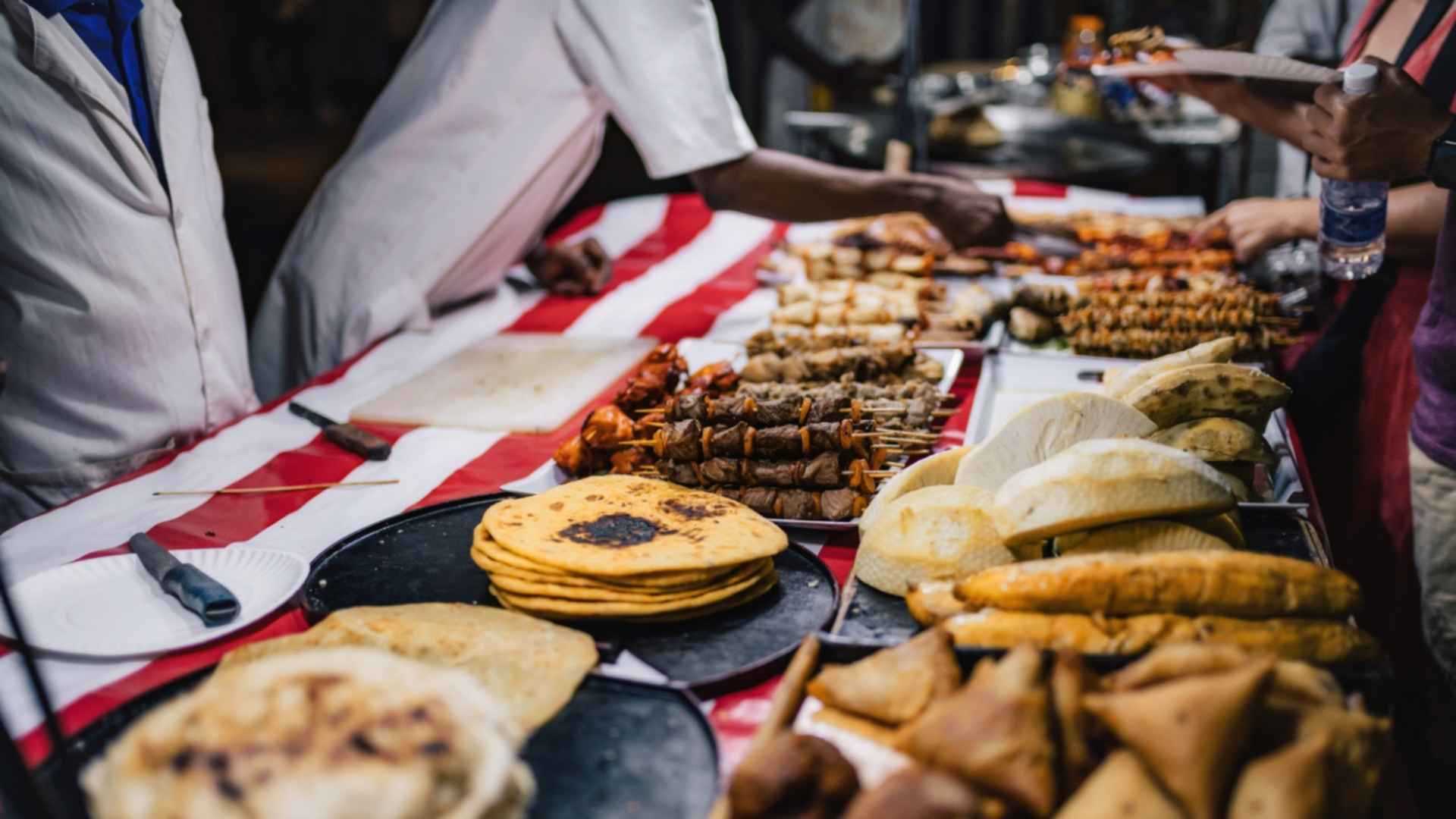Tanzanian food you don't want to miss
In Tanzania, food is a vibrant reflection of its diverse culture. From bustling city streets to serene coastal villages, the traditional dishes have a story and flavour that captures the essence of this beautiful country.
But navigating menus, understanding local ingredients, and finding dishes that suit your dietary needs can be tricky for first-time visitors.
In this article, you’ll get a breakdown of Tanzania’s food. By the end, you’ll know all the must-try dishes, key ingredients and spices, and regional specialties to look out for.
Here’s what you’ll learn:
- Nine of the must-try traditional foods of Tanzania
- Key facts about Tanzanian food
- What you need to know about dining in Tanzania
- How to navigate dietary requirements in Tanzania
- Answers to common questions about popular food in Tanzania
The best food in Tanzania: 9 must-try dishes
Whether you’re climbing Kilimanjaro or relaxing in Zanzibar, these nine local dishes are worth trying:
1. Ugali
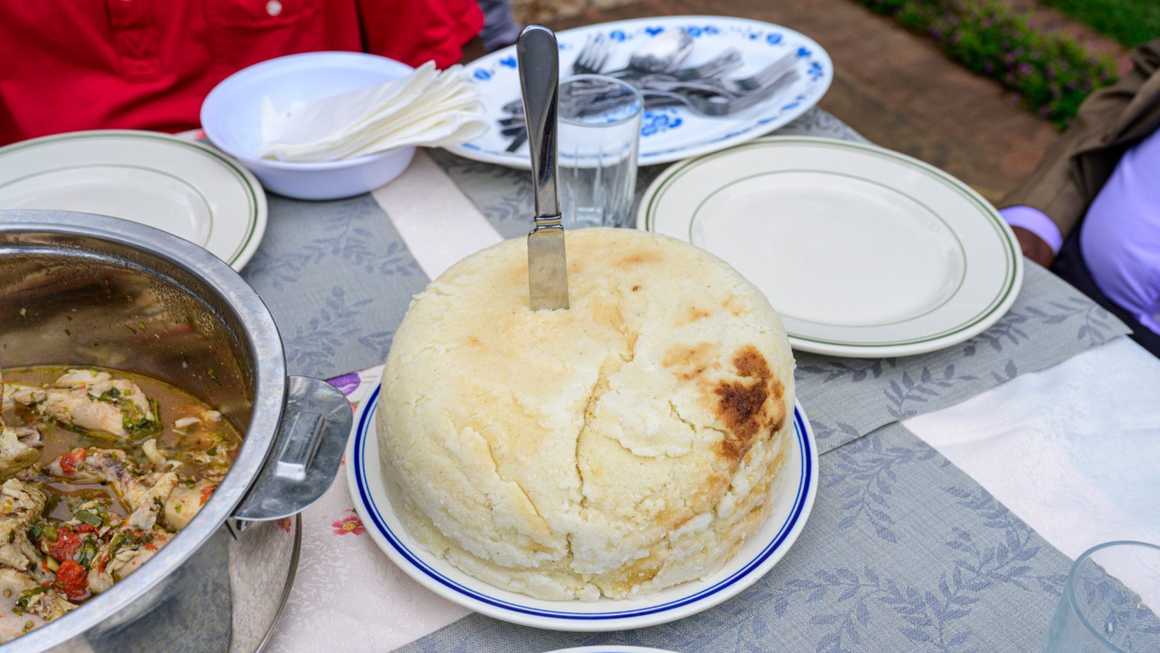
Spice level: None
Unique flavours: Mild, earthy, comforting
Best eaten with: Sauces, vegetables, or meat stews
Ugali is a porridge-like dough made from cornflour and water or milk. It’s one of the most common foods in Tanzania, with a simple, comforting flavour.
This dish is typically eaten with hands. Shaped into a flatish oval, a shallow depression is made with the thumb, allowing sauces, meats, or vegetables to be scooped up and enjoyed together.
Despite its simplicity, it’s a dish that forms the heart of Tanzanian culture – from busy city homes to rural villages. A plate of ugali might seem plain at first, but combined with rich stews or fresh greens, it’s a culinary canvas for bold flavours.
2. Nyama choma

Spice level: Mild to medium
Unique flavours: Smoky, charred, savoury
Best eaten with: Kachumbari (tomato and onion salad relish), rice, ugali
Nyama choma is a grilled meat dish. It’s a traditional food in Tanzania, typically made from beef, goat, or sometimes chicken. The meat is marinated lightly, grilled slowly over open flames, and served fresh.
Locals often enjoy nyama choma during weekend gatherings or after a long day of work. Paired with kachumbari and sometimes a cold beer, it’s an unforgettable taste of Tanzanian hospitality.
3. Zanzibar pilau
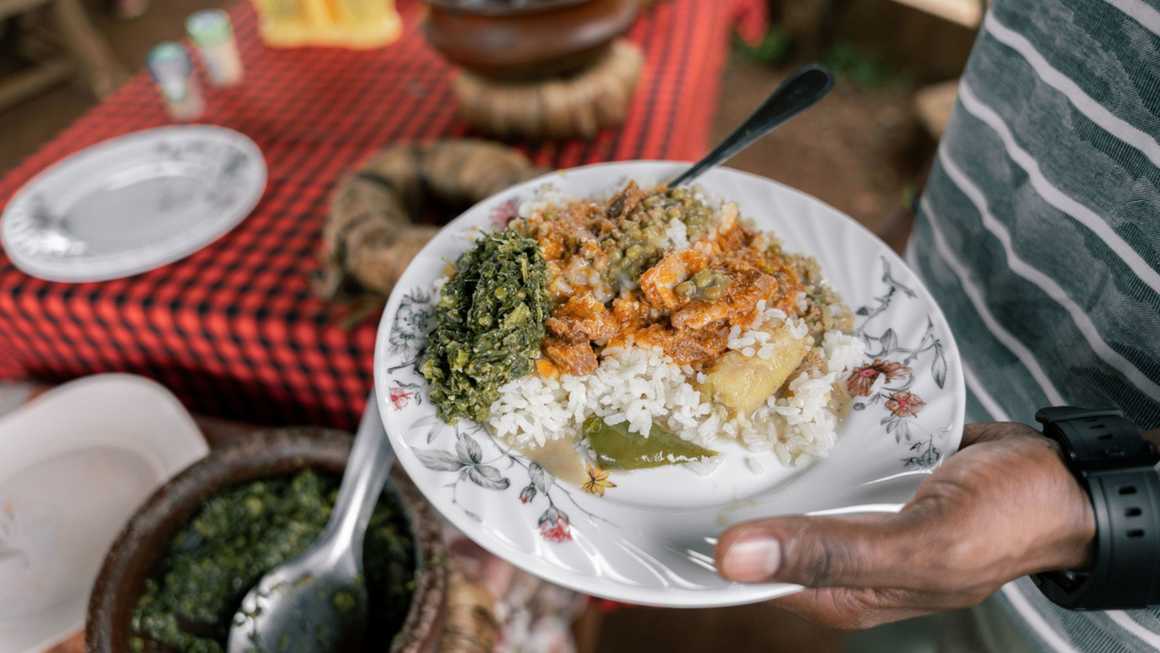
Spice level: Mild
Unique flavours: Fragrant, aromatic, slightly sweet
Best eaten with: Beef, chicken, or vegetable stews
Zanzibar pilau is a rice dish that combines cloves, cinnamon, cardamom, and cumin, creating a fragrant, slightly sweet flavour that infuses every grain.
It's a popular food eaten in Tanzania, but is also traditionally served at weddings and festive occasions. Pilau can be paired with meats, vegetables, or eaten on its own as a flavourful main dish.
4. Mchuzi wa samaki
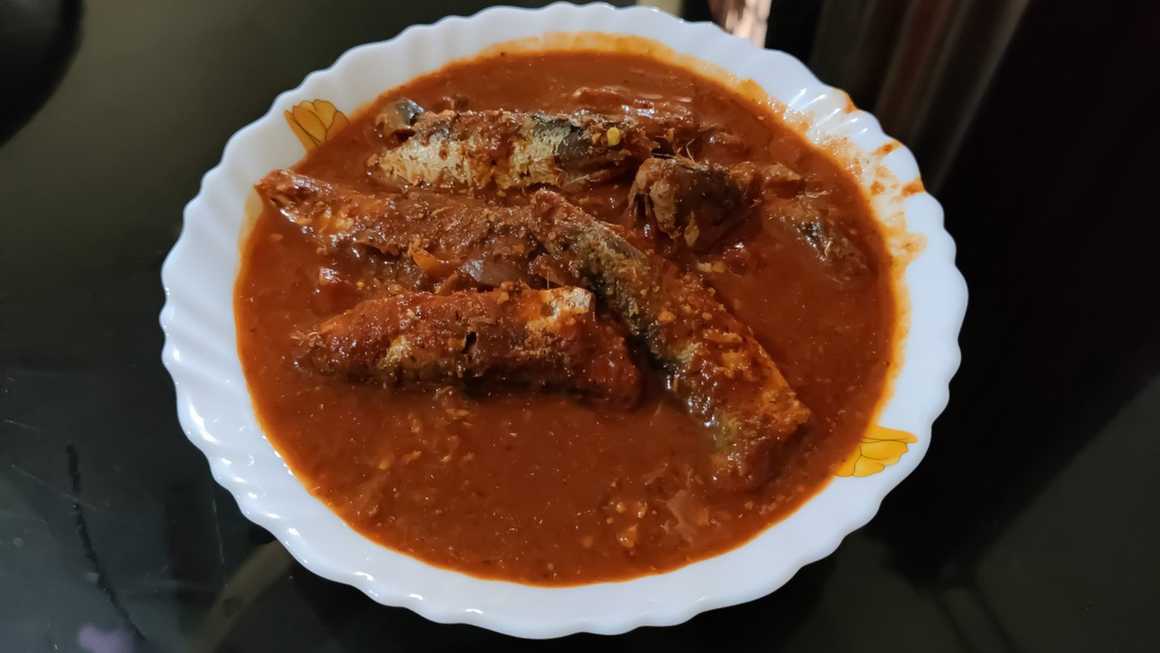
Spice level: Medium
Unique flavours: Creamy, coconut-rich, tangy with hints of tomato
Best eaten with: Rice, chapati, or steamed plantains
A coastal favourite, mchuzi wa samaki is a coconut-based fish curry bursting with flavour. Freshly caught fish is simmered in a sauce of coconut milk, tomatoes, garlic, and a blend of aromatic spices.
Locals enjoy it at lunch or dinner, often accompanied by steamed rice or soft chapati. Each bite offers a balance of creamy richness and tangy spice that reflects Tanzania’s coastal heritage.
5. Chapati
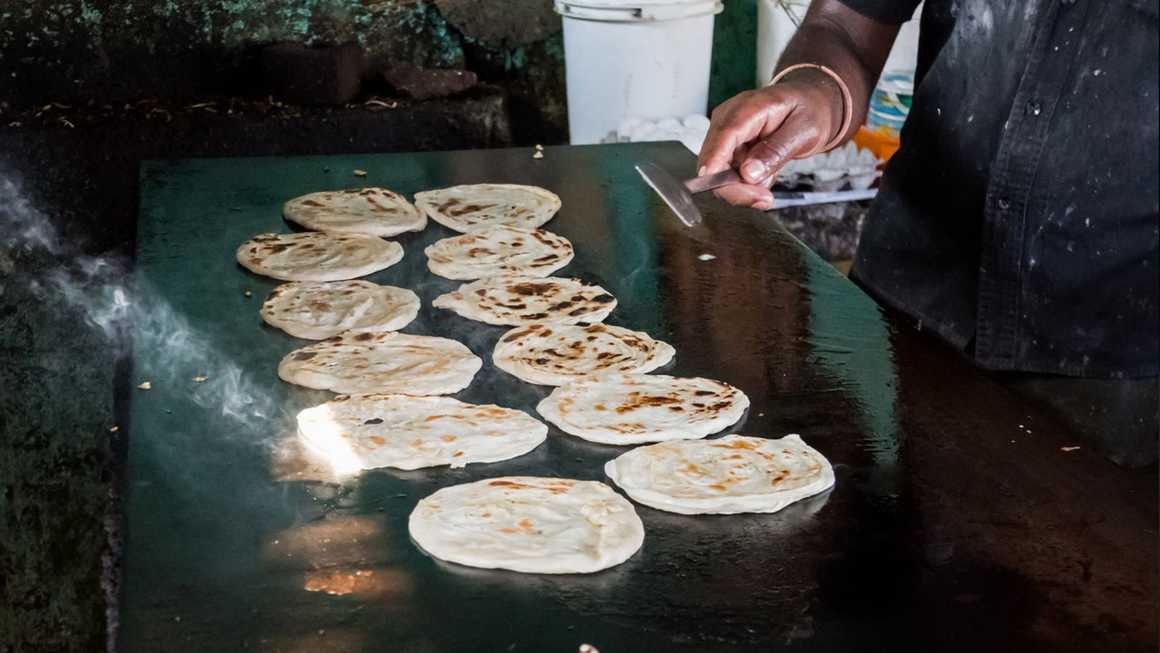
Spice level: None
Unique flavours: Buttery, soft, slightly sweet
Best eaten with: Beans, stews, or tea
Tanzanian chapati is a deliciously soft flat-bread inspired by Indian cuisine. Over time, it’s evolved into a soft, thicker, and slightly sweeter version of the Indian classic. Many locals eat it with bean stews, sauces, or simply with tea for breakfast.
While simple in ingredients, the technique of layering and frying creates a rich, chewy texture that makes chapati uniquely satisfying.
6. Mishkaki
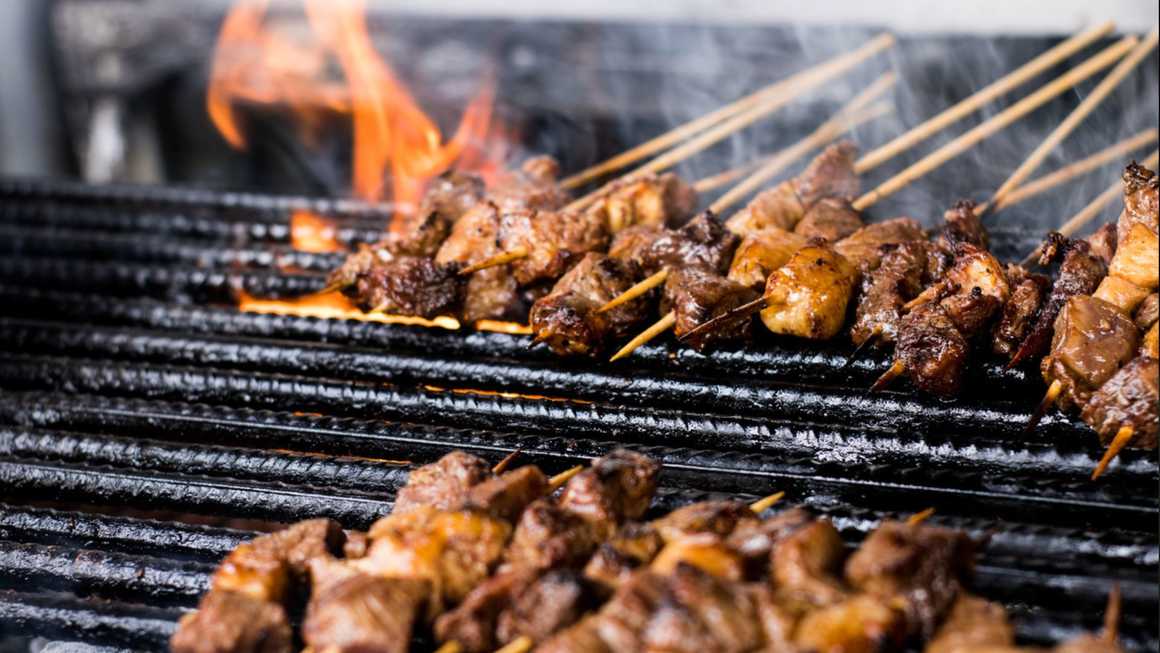
Spice level: Medium
Unique flavours: Smoky, tangy, garlicky, slightly spicy
Best eaten with: Rice, kachumbari, or as a street snack
Mishkaki are marinated meat skewers, grilled over charcoal to create a smoky and delicious flavour. Popular as street food or at evening markets, the meat is marinated in a mixture of lime, chili, garlic, and spices before being cooked.
Each skewer offers a smoky, flavourful bite that pairs perfectly with a tangy salad or a cold beverage. Street vendors often serve them hot off the grill, making it a must-try while exploring Tanzania.
7. Ndizi Nyama
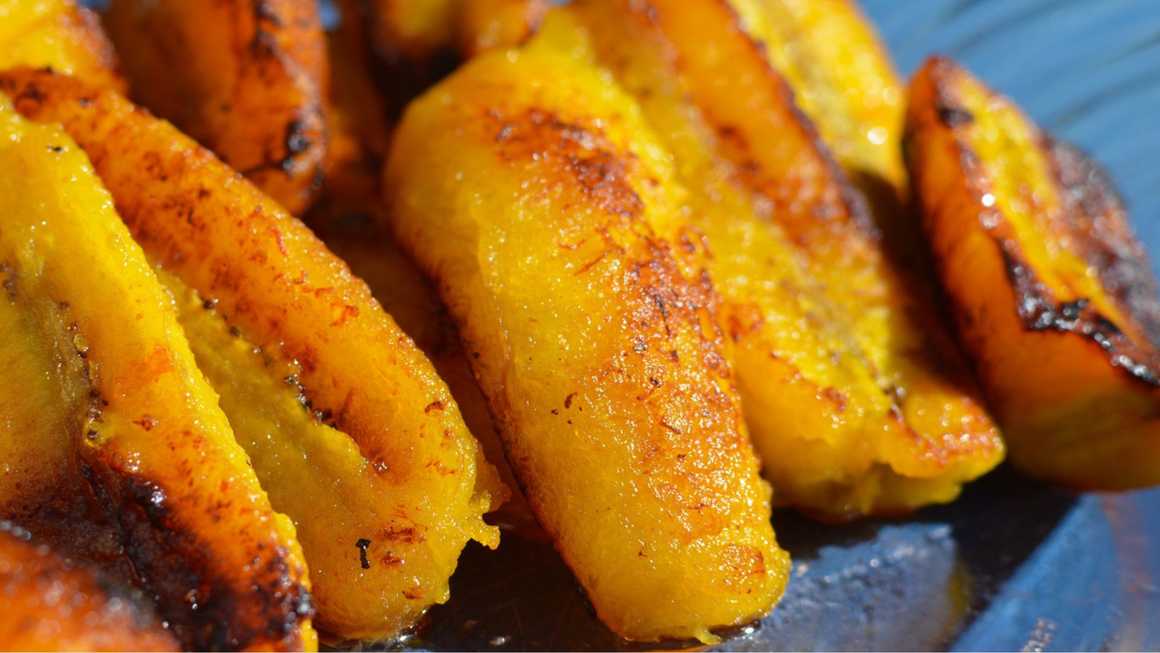
Spice level: Mild to medium
Unique flavours: Sweet-savory, rich, comforting
Best eaten with: Steamed rice or ugali
Ndizi Nyama is a traditional Tanzanian dish that combines the natural sweetness of plantains with tender pieces of meat, usually beef or goat. The ingredients are cooked in a rich, savoury sauce, often prepared with coconut milk.
It’s a staple food in Tanzania, giving visitors a sense of traditional, home-cooked comfort meals.
8. Mandazi

Spice level: None
Unique flavours: Sweet, lightly spiced with cardamom or coconut
Best eaten with: Tea, coffee, or as a breakfast snack
Mandazi are East African doughnuts – slightly sweet, soft, and fried to golden perfection. Flavoured with cardamom, coconut milk, or nutmeg, these doughnuts are perfect for breakfast or as a mid-day snack.
Locals often enjoy them with chai or coffee from street vendors, markets, and cafés that serve them fresh.
9. Urojo
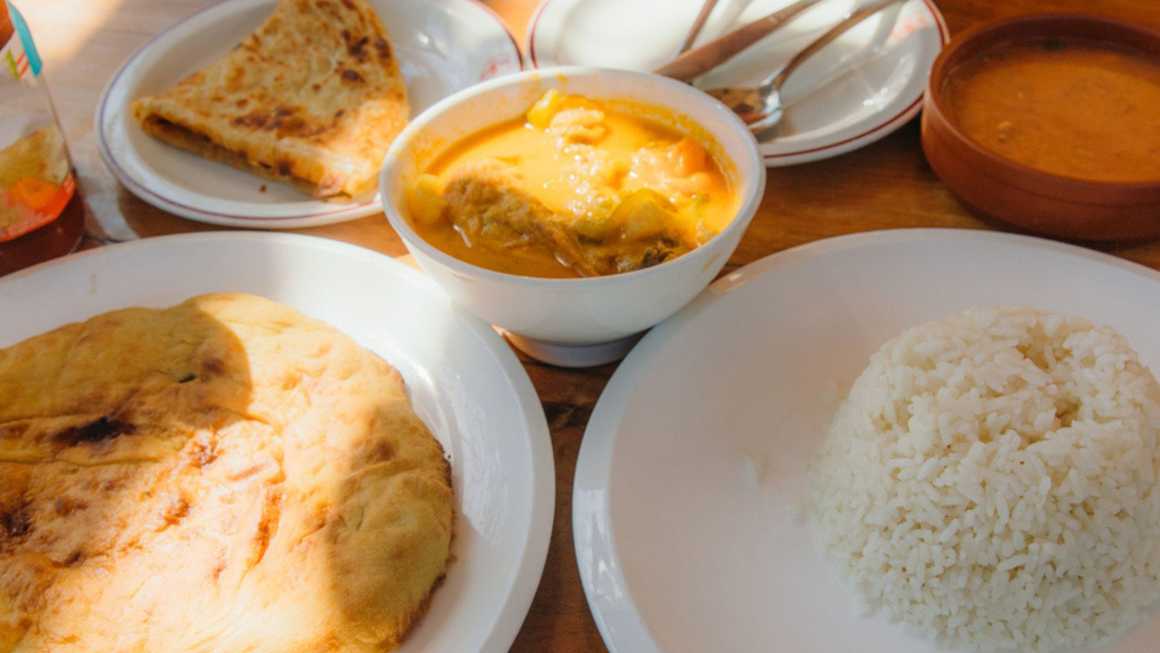
Spice level: Medium to hot
Unique flavours: Tangy, spicy, layered with textures
Best eaten with: Fresh lime, chutney, and hot tea
Urojo is a Tanzania street food sensation unique to Zanzibar. Also called “Zanzibar Mix,” it’s a tangy, hearty soup made with chickpea flour, potatoes, cassava, and deep-fried fritters, topped with chutneys, lime, and chili.
It’s usually eaten for lunch or as a snack. Street vendors often serve it piping hot, straight from the pot. Every spoonful is a mix of textures and flavours – creamy, crunchy, spicy, and tangy at the same time.
What you need to know about typical food in Tanzania, Africa
Tasting local food in Tanzania is one of the best ways to experience the country’s rich culture and traditions. From bustling city markets to coastal fishing villages, Tanzanian cuisine blends fresh, seasonal ingredients with bold spices and simple cooking techniques.
Here are some of the flavours, ingredients, and preparation styles that make the country’s dishes so unique.
Staple starches
Traditional foods in Tanzania usually include a starch that serves as the foundation of the meal.
Here are the common options:
- Ugali. As mentioned, ugali is a thick porridge made from maize flour (cornmeal) and water. It’s dense and slightly sticky, but absorbs the rich flavours of accompanying stews or sauces.
- Rice. In Tanzania, rice is frequently flavoured with spices in dishes like Pilau or cooked with coconut milk in Wali wa Nazi (coconut rice). Rice provides a lighter, fluffier alternative to ugali and is common in coastal and urban areas.
- Plantains. Similar to bananas but starchier and less sweet when green. Plantains can be boiled, fried, or mashed, often served alongside meat or fish stews. Ripe plantains become sweet and are sometimes cooked with coconut milk for a rich, comforting dish.
- Cassava . A root vegetable that’s boiled, fried, or mashed. Cassava is dense and starchy, often used in rural areas as a filling side or incorporated into stews.
- Chapati. A layered flatbread originally from India, adapted locally into a thicker, softer version. Chapati is typically pan-fried and can be eaten with curries, stews, or beans.
Proteins
Proteins in Tanzanian dishes come from land animals, seafood, and legumes, reflecting both inland and coastal culinary traditions.
Take a look at some of the most popular proteins in Tanzania:
- Beef and goat. Beef is a common food in Tanzania, while goat meat is particularly popular in rural areas. These meats are used in Nyama Choma (grilled meat), stews, and curries. Goat is known for its distinct, slightly gamey flavour that pairs well with bold spices.
- Chicken. Chicken is widely available and used in curries, stews, or grilled dishes. It’s often cooked with onions, garlic, ginger, and local spices to add depth of flavour.
- Fish and seafood. Along the coast and on Zanzibar, fresh fish, prawns, octopus, and crabs are staples. Fish is commonly cooked in coconut-based sauces, grilled, or curried, emphasising the coastal influence of Indian and Arab cuisine.
- Beans and legumes. Beans, lentils, and chickpeas are key vegetarian proteins. They’re slow-cooked or simmered in tomato-based sauces and often served with rice or ugali. They provide a hearty, protein-rich option for meat-free diets.
Vegetables
Vegetables in Tanzanian mains are often seasonal and locally sourced, adding nutrition, color, and texture to meals.
Check out some of the common vegetable options:
- Leafy greens. Popular varieties include sukuma wiki (collard greens), spinach, and amaranth. Typically sautéed with onions, tomatoes, and spices, they provide a slightly bitter contrast to richer meats and starches.
- Tomatoes and onions. Core ingredients in many stews and sauces. Tomatoes add sweetness and acidity, while onions provide depth and a savory base. Together, they form the backbone of sauces for meat, beans, and vegetable dishes.
- Peppers and chili. Both fresh and dried peppers add heat and spice to dishes, though Tanzanian meals are usually moderately spiced compared to other East African cuisines. Coastal dishes may be spicier due to Indian influence.
- Root vegetables. Potatoes, carrots, and cassava appear in stews, soups, and sometimes fried dishes. They add substance and absorb surrounding flavours.
Aubergine, okra, pumpkin, and green beans are also used depending on the region and season. Okra is often cooked in stews to add a thick, slightly viscous texture.
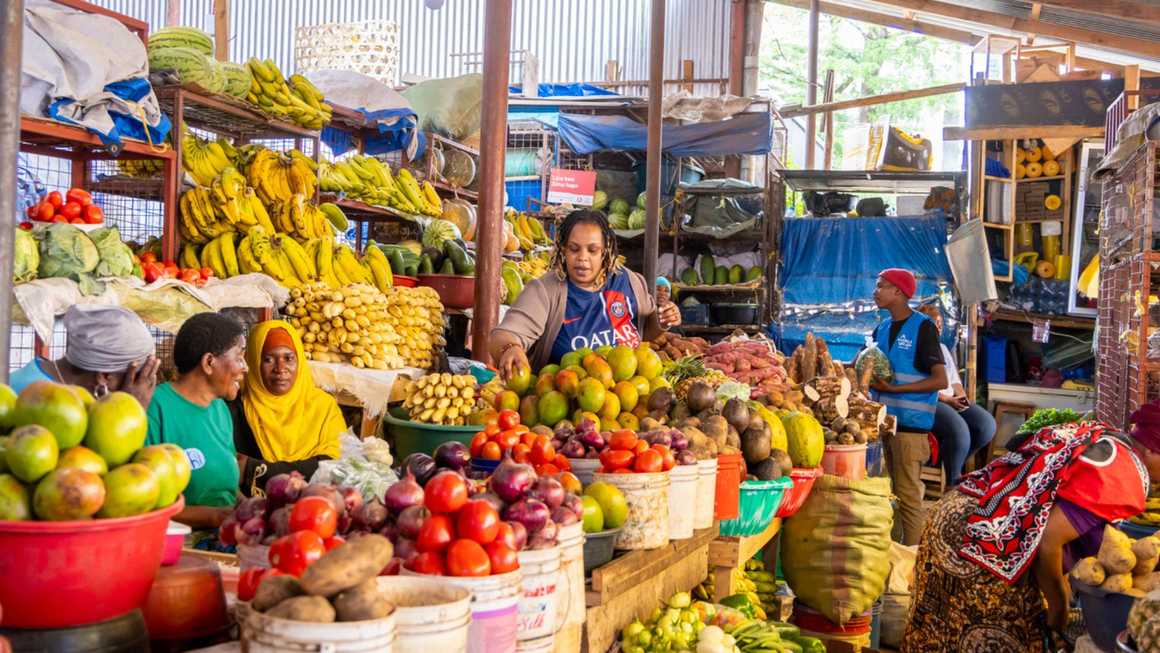
Key herbs, spices, and sauces
Flavour is central to Tanzanian cooking. Combining fresh herbs, spices, and sauces brings dishes to life, creating bold and rich tastes.
Here are some flavours and sauces you’ll find in Tanzanian cooking:
- Coconut milk. Especially used in coastal dishes and curries, coconut milk adds a rich, creamy texture and balances spicy or tangy flavours.
- Garlic, ginger, and turmeric. These aromatics are used in meat, seafood, and vegetable dishes to provide warmth and depth.
- Cloves, cardamom, and cinnamon. Often used in rice dishes such as Pilau and during festive occasions. These spices give the cuisine in Tanzania its distinctive aroma and subtle sweetness.
- Tomato-based sauces. A staple in stews and curries. Tomatoes provide acidity and a savoury base for layering flavours.
- Lime and tamarind. Used for tanginess, especially in coastal dishes or street foods like Urojo.
- Peanut sauces. Occasionally used with vegetable or meat stews inland. They add creaminess and a slightly nutty flavour.
Typical food preparation styles in Tanzania
From the smoky aroma of grilled meats to the comforting richness of stews, Tanzanian cooking methods bring out distinct tastes and textures.
Here are some of the most common methods of Tanzanian cooking:
- Grilled. Meat and fish are often cooked over open flames, adding a smoky aroma (like in Nyama Choma).
- Stewed. Chefs simmer meat, fish, and vegetables in sauces to tenderise proteins and infuse flavour.
- Fried. Snacks like Mandazi, fried plantains, and cassava chips are fried until golden and crispy.
- Boiled and steamed. Root vegetables, rice, and plantains are often boiled or steamed to retain natural flavours.
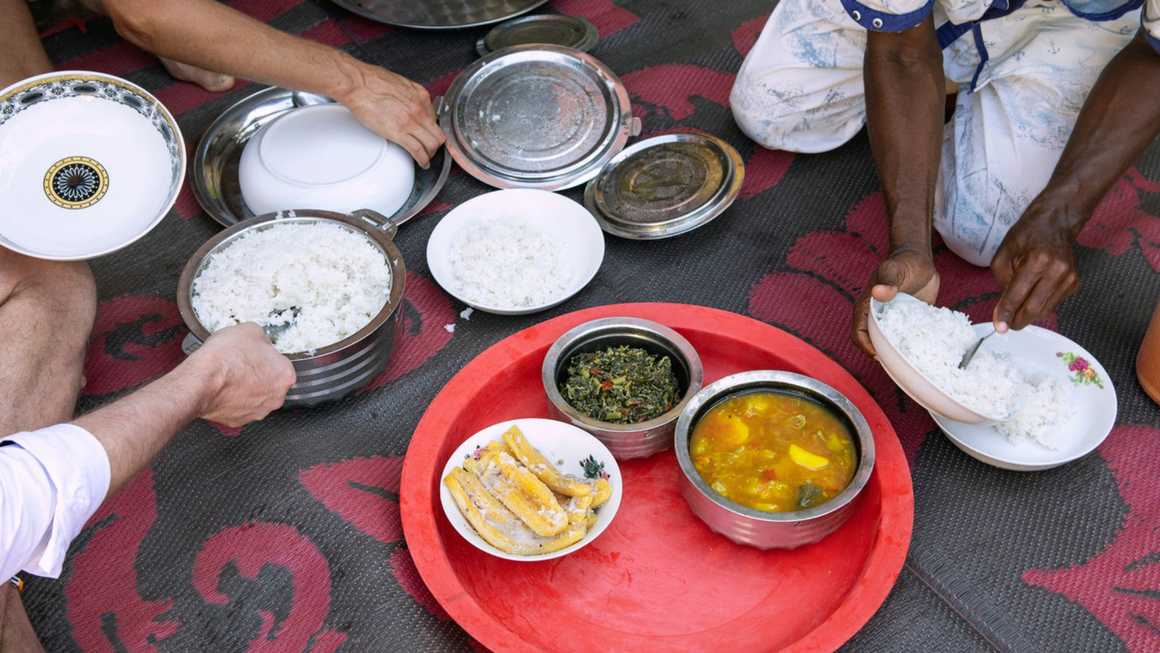
Eating in Tanzania with dietary requirements
Travelling with dietary requirements can be tricky to navigate, but manageable with the right preparation.
Here are some tips for navigating the cuisine of Tanzania with dietary requirements:
- Vegan and vegetarian food in Tanzania. Dishes like ugali with vegetables, beans, and some rice dishes can easily be enjoyed meat-free. Ask for “bila nyama” (without meat) to ensure vegetarian options.
- Gluten-free options. Staples such as ugali, rice, plantains, and many stews are naturally gluten-free. Avoid fried snacks like mandazi and chapati unless specifically made without wheat.
- Halal meat. Most meat, especially in coastal regions like Zanzibar, is halal. Muslim-friendly options are widely available.
- Allergies. Coconut, peanuts, and sesame appear in many dishes, so keep an eye out for these on the menu or familiarise yourself with ingredients beforehand.
Tanzania is generally welcoming to travellers with dietary needs, but communication is key. If you have any dietary requirements, allergies, or intolerances, speak to food providers directly about ingredients and food preparation methods to make sure the food is safe.
To say "I have an allergy" in Tanzania, you can say “nina mzio” or "nina mzio na" followed by the allergen.
Using a translation card is also a good idea when travelling overseas with allergies.
The card provides a clear and comprehensive message in Swahili to restaurants and staff. As a result, there’s no translation errors when communicating your dietary needs. Check out this information from Allergy UK about how to order a food allergy card!
FAQs about Tanzanian food
Is Tanzanian cuisine spicy?
Typically, no – Tanzanian food isn’t very spicy. Some dishes can be mildly to moderately spicy, particularly in coastal regions like Zanzibar where Indian and Arabic influences are strong.
Western food is also widely available in all but the most remote areas, so you’ll never be far from familiar options. Chips, fried chicken, pizzas, salads, pasta can usually be found wherever there are visitors.
These options make it easy to enjoy local flavours while having familiar choices on hand if needed.
Are there local beverages I should try?
Yes! Try Tanzanian tea, coffee (grown locally in regions like Kilimanjaro), fresh fruit juices, and traditional drinks like banana beer or tonto (fermented banana drink).
What is the famous food in Tanzania?
Some of Tanzania’s most famous foods include ugali (maize porridge), nyama choma (grilled meat), pilau (spiced rice), samosas, mandazi (fried dough), and fish in coconut sauce, especially along the coast.
What is the national dish of Tanzania?
The national food of Tanzania is ugali, a stiff maize porridge often served with vegetables, meat, or fish. It’s a staple across the country and forms the basis of most meals.
What do Tanzanians eat for breakfast?
Typical breakfasts include mandazi (sweet fried dough), chapati (flatbread), tea with milk, porridge, and sometimes eggs or beans.
What food is served in Zanzibar?
Zanzibar cuisine is heavily influenced by Arabic, Indian, and African flavors. Popular dishes include pilau rice, biryani, samaki wa kupaka (fish in coconut sauce), spiced meats, fresh seafood, and tropical fruits. Street foods like roasted corn are also common.
How much does food cost in Tanzania?
The cost of food in Tanzania varies depending on where you are in the country and the type of food operator. Meals from street vendors and market stalls cost an average of £2.15* (7,000 TSh) while mid-range restaurants are around £15.32 (50,000 TSh) for two people.
*Prices and conversion rates are accurate at the time of publishing.

Explore Tanzania: Culture, cuisine, and adventure
Tanzanian food focuses on fresh, local ingredients with a balance of starches, proteins, vegetables, and bold flavours. The cuisine emphasises communal eating, seasonal produce, and simple cooking methods that let the natural flavours shine.
Whether you’re in the city or on the coast, understanding these ingredients helps you navigate menus, enjoy street food safely, and experience authentic Tanzanian meals.
And if you want to immerse yourself in Tanzanian culture even further, why not join an adventure trip?
Tanzania boasts breathtaking natural attractions, from Mount Kilimanjaro’s snow-capped peak to vast national parks, wildlife reserves, and unspoiled beaches. Its 804 km coastline and nearby islands (Zanzibar, Pemba, and Mafia) offer rich natural, cultural, and historical experiences.
With Kandoo, you can explore these areas with the comfort and safety of an expert guide. Share the adventure with a group of like-minded individuals and experience Tanzania in an entirely new light!










